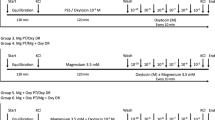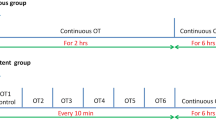Abstract
Recent biomolecular studies have shown that continuous exposure of human myometrial cells to oxytocin results in a significant loss of responsiveness to subsequent oxytocin stimulation, perhaps because of desen-sitization of the oxytocin receptors. However, it is unclear whether this phenomenon results in a reduction of the contractile activity of the uterine muscle in humans or animals. The objective of our study was to investigate the in vitro response of the uterine muscle of pregnant rats to oxytocin, following preexposure to varying concentrations of oxytocin, for varying durations. Longitudinal myometrial strips were isolated from 16 pregnant Wistar rats at 19 to 21 days of gestation and preexposed to oxytocin 10 or 10–8 mol/L (experimental groups) or physiological salt solution (control groups) for 1- or 4-hour period. All muscle strips were then subjected to a dose-response study with oxytocin 10 to 10 mol/L. The area under the curve, frequency, and amplitude of contractions were recorded and compared between the groups. The area under the curve, frequency, and amplitude of the oxytocin-induced contractions were all significantly suppressed in the groups preexposed to oxytocin 10 mol/L compared to either the control groups (P < .0001) or the groups preexposed to oxytocin 10 mol/L (P < .0001). There was no difference in the oxytocin-induced myometrial contractions between the groups preexposed to oxytocin for either the 1- or 4-hour periods. The inhibition of the oxytocin-induced contractile response of pregnant rat myometrium is observed as early as 1 hour of preexposure to oxytocin and is dependent on the preexposed oxytocin concentration and not on the duration of its exposure.
Similar content being viewed by others

References
Mitchell BF, Fang X, Wong S. Oxytocin: a paracrine hormone in the regulation of parturition? Rev Reprod. 1998;3: 113–122.
Phaneuf S, Europe-Finner GN, Vamey M, MacKenzie IZ, Watson SP, Lopez Bemal A. Oxytocin-stimulated phosphoi-nositide hydrolysis in human myometrial cells: involvement of pertussis toxin-sensitive and -insensitive G-proteins. J Endocrinol. 1993;136:497–509.
Robinson C, Schumann R, Zhang P, Young RC. Oxytocin-induced desensitization of the oxytocin receptor. Am J Obstet Gynecol. 2003;188:497–502.
Phaneuf S, Asboth G, Carrasco MP, et al. Desensitization of oxytocin receptors in human myometrium. Hum Reprod Update. 1998;4:625–633.
Phaneuf S, Rodriguez Linares B, TambyRaja RL, MacKenzie IZ, Lopez Bemal A. Loss of myometrial oxytocin receptors during oxytocin-induced and oxytocin-augmented labour. J Reprod Fertil. 2000;120:91–97.
Phaneuf S, Asboth G, MacKenzie IZ, Melin P, Lopez Bernal A. Effect of oxytocin antagonists on the activation of human myometrium in vitro: atosiban prevents oxytocin-induced desensitization. Am J Obstet Gynecol. 1994;171:1627–1634.
Adachi S, Oku M. The regulation of oxytocin receptor expression in human myometrial monolayer culture. J Smooth Muscle Res. 1995;31:175–187.
Phaneuf S, Asboth G, Carrasco MP, et al. The desensitization of oxytocin receptors in human myometrial cells is accompanied by down-regulation of oxytocin receptor messenger KNA. J Endocrinol. 1997;154:7–18.
Karsli B, Kayacan N, Kucukyavuz Z, Mimaroglu C. Effects of local anesthetics on pregnant uterine muscles. Pol J Pharmacol. 2003;55:51–56.
Yoo KY, Lee J, Kim HS, Jeong SW. The effects of opioids on isolated human pregnant uterine muscles. Anesth Analg. 2001;92:1006–1009.
Choi J, Hammer LW, Hester RL. Calcium-dependent synthesis of prostacyclin in ATP-stimulated venous endothelial cells. Hypertension. 2002;39:581–585.
Li Z, Zhou L, Tang Hui-fang. Effects of levobupivacaine and bupivacaine on rat myometrium. J Zhejiang Univ Sci B. 2006;7:757–762.
Bengtsson B, Chow EM, Marshall JM. Activity of circular muscle of rat uterus at different times in pregnancy. Am J Physiol. 1984;246:C216–C223.
Meisheri KD, McNeill JH, Marshall JM. Effect of isoproterenol on the isolated pregnant rat myometrium. Eur J Pharmacol. 1979;60:1–6.
Carvalho JC, Balki M, Kingdom J, Windrim R. Oxytocin requirements at elective cesarean delivery: a dose-finding study. Obstet Gynecol. 2004;104:1005–1010.
Balki M, Ronayne M, Davies S, et al. Minimum oxytocin dose requirement after cesarean delivery for labor arrest. Obstet Gynecol. 2006;107:45–50.
Kantas E, Cetin A, Kaya T, Cetin M. Effect of magnesium sulfate, isradipine, and ritodrine on contractions of myometrium: pregnant human and rat. Acta Obstet Gynecol Scand. 2002;81:825–830.
Yildiz K, Dogru K, Dalgic H, et al. Inhibitory effects of des-flurane and sevoflurane on oxytocin-induced contractions of isolated pregnant human myometrium. Acta Anaesthesiol Scand. 2005;49:1355–1359.
Fielitz CA, Gonzalez Panizza VH, Caldeyro-Barcia R. Effect of low concentrations of oxytocin on the uterine response to electrical stimulation. Acta Physiol Lat Am. 1960;10:201–204.
Higuchi T, Todokoro Y, Honda K, Negoro H. Detailed analysis of blood oxytocin levels during suckling and parturition in the rat. J Endocrinol. 1986;110:251–256.
Goodfellow CF, Hull MG, Swaab DF, Dogterom J, Buijs RM. Oxytocin deficiency at delivery with epidural analgesia. Br J Obstet Gynaecol. 1983;90:214–219.
Seitchik J, Amico J, Robinson AG, Castillo M. Oxytocin augmentation of dysfunctional labor. IV. Oxytocin pharmacokinetics. Am J Obstet Gynecol. 1984;150:225–228.
Garfield RE, Blennerhasssett MG, Miller SM. Control of myometrial contractility: role and regulation of gap junctions. Oxf Rev Reprod Biol. 1988;10:436–490.
Author information
Authors and Affiliations
Corresponding author
Additional information
This study was supported by funding from Dean’s Fund, University of Toronto; Department of Obstetrics & Gynaecology, Mount Sinai Hospital; and Department of Anesthesia, University Health Network-Mount Sinai Hospital (UHN-MSH), University of Toronto.
This paper won the award for “Best paper in Obstetric Anesthesia” at the Canadian Anesthesiology’s Society Meeting, Halifax, Nova Scotia, June 13–17, 2008. It was also presented as oral presentation in the best paper competition at the 40th Annual Meeting of the Society for Obstetric Anesthesia and Perinatology, Chicago, Illinois, April 30-May 4, 2008. We would like to thank Dr Stephen Lye, Associate Director, Research, and Dr Lee Adamson, Senior Investigator, Samuel Lunenfeld Research Institute, for providing us with the lab space as well as for their guidance and support while we were setting up the lab. We would like to acknowledge Dr Marco Magalhaes for his generous help with the equipment assembly and technical support. We are grateful to Dr Venu Jain, Dr Steffen-Sebastian Bolz, and Dr Jaques Belik from the University of Toronto for their continual guidance during the conduct of the experiments.
Rights and permissions
About this article
Cite this article
Magalhaes, J.K.R.S., Carvalho, J.C.A., Parkes, R.K. et al. Oxytocin Pretreatment Decreases Oxytocin-induced Myometrial Contractions in Pregnant Rats in a Concentration-dependent But Not Time-dependent Manner. Reprod. Sci. 16, 501–508 (2009). https://doi.org/10.1177/1933719108329954
Published:
Issue Date:
DOI: https://doi.org/10.1177/1933719108329954



